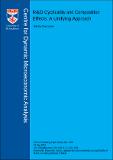Files in this item
R&D cyclicality and composition effects : a unifying approach
Item metadata
| dc.contributor.author | Chernyshev, Nikolay | |
| dc.date.accessioned | 2017-10-04T11:30:22Z | |
| dc.date.available | 2017-10-04T11:30:22Z | |
| dc.date.issued | 2017-09-27 | |
| dc.identifier | 251245494 | |
| dc.identifier | 51c723bb-5c8e-4bf4-8954-00f5629e1fa6 | |
| dc.identifier.citation | Chernyshev , N 2017 ' R &D cyclicality and composition effects : a unifying approach ' CDMA Working Paper , no. 1705 . | en |
| dc.identifier.uri | https://hdl.handle.net/10023/11790 | |
| dc.description.abstract | Existing empirical studies do not concur on whether R&D spending is procyclical or countercyclical: the former hypothesis is supported by studies of aggregate R&D spending, whereas the latter is vindicated by firm-level evidence. In this paper, we reconcile the two facts by advancing a general equilibrium framework, in which, while a single firm's R&D spending profile is countercyclical, aggregate R&D spending is procyclical owing to procyclical fluctuations in the number of R&D performers. Our findings suggest that economic crises might be beneficial for economic performance by fostering individual R&D effort. An advantage of our framework is that it brings together conflicting pieces of empirical evidence, while incorporating and building upon Schumpeter's hypothesis of countercyclical innovation. | |
| dc.format.extent | 32 | |
| dc.format.extent | 749596 | |
| dc.language.iso | eng | |
| dc.relation.ispartofseries | CDMA Working Paper | en |
| dc.subject | Economic cycles | en |
| dc.subject | Opportunity cost hypothesis | en |
| dc.subject | Procyclicality of R&D | en |
| dc.subject | Countercyclicality of R&D | en |
| dc.subject | HB Economic Theory | en |
| dc.subject.lcc | HB | en |
| dc.title | R&D cyclicality and composition effects : a unifying approach | en |
| dc.type | Working or discussion paper | en |
| dc.contributor.institution | University of St Andrews. School of Economics and Finance | en |
| dc.contributor.institution | University of St Andrews. Centre for Dynamic Macroeconomic Analysis | en |
| dc.identifier.url | https://ideas.repec.org/p/san/cdmawp/1705.html | en |
This item appears in the following Collection(s)
Items in the St Andrews Research Repository are protected by copyright, with all rights reserved, unless otherwise indicated.

